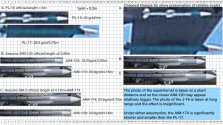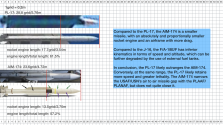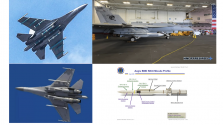SM-6 ship launch has a solid fuel booster, but the SM-6 missile itself has a dual thrust motor. I believe this is the same as the HQ-9, since the HQ-9 does not have a visible booster section.Unlike HQ-9 the air to air version appears to be a single stage missile whereas both HQ-9 and SM-6 ship launched are two stage missiles iirc.
Oh another reason SAMs have larger diameter is to house a heavier warhead. Yet another optimisation issue wrt conversions.
You are using an out of date browser. It may not display this or other websites correctly.
You should upgrade or use an alternative browser.
You should upgrade or use an alternative browser.
Chinese air to air missiles
- Thread starter tphuang
- Start date
Ultra long range AAMS are about maximizing range as long as speed/altitude is reasonable, so maybe not surprising that they start to look like long range MLRS rockets proportion wise. (I know there were a couple of long range fat ones too)There's a reason why SAMs feature larger diameters than their A2A counterparts. Could this be due to requiring that much more fuel volume to overcome altitude difference while preserving range and flight characteristics especially wrt steering post boost? Seems the sans booster SM-6 is a better SAM to convert for A2A as it appears more in line with typical thinner AAM diameters and length to width proportions. My guess is an AAM being fired at around mach 1 and at altitude means it can slim its frame down and lose that extra fuel to maximise speed and reduce drag vs a long range SAM requiring that extra volume. It a long range SAM kept the same proportions, it may be an issue wrt acceleration stresses on the frame during boost. Also seems to require considerably more boost to overcome inertia. So on balance, we have this convergence where medium to long/ultra-long ranged AAMs are usually thinner and longer in proportion compared to long range SAMs. Been true since the HAWK and Guideline. AAMs converted to SAMs though ... plenty of examples of those, usually medium ranged AAMs and ends up being point defense SAMs. Business case issue perhaps.
Unlike HQ-9 the air to air version appears to be a single stage missile whereas both HQ-9 and SM-6 ship launched are two stage missiles iirc.
The HQ-9 makes use of thrust vectoring and the SM-6 uses fins. Nearly 7m for HQ-9 full length. Compare their diameters. No PLAAF/PLANAF fighter in current service is going to be carrying a HQ-9 under a wing. I suppose that's why PL-17 and P-21 are the ULRAAMs. I've no doubt the "ballistic", rocket only missile will not have the HQ-9's diameter. Converting a HQ-16/Buk to A2A? R-37M sort of resembles that but not quite. Still a completely different missile. The Americans just saved a tonne of money and time to field a ULRAAM with the SM-6. Good for them but in the past they would have developed a ground up latest and greatest new AAM. Maybe the AIM-260 is where the resources have gone. A2A SM-6 is admittedly what I'd have done a long time ago. It's really one of the few SAMs that can be suitably converted to an AAM.
Oh another reason SAMs have larger diameter is to house a heavier warhead. Yet another optimisation issue wrt conversions.
But then the fat ones looks like air launched supersonic anti-ship missiles.
I have not seen a size comparison between the PL-17 and the new AIM-174 aka "air launched SM-6 without the booster) of the USN. So I made these:View attachment 132853View attachment 132854
Unedited images:
View attachment 132855
The effort put into the scaled comparison is useful, but your overall picture would be far stronger if you omitted the part speculating about range and relative capability.
Those aspects cannot and shouldn't be quantifiable yet by those of us in the public space given that needs to be viewed in terms of the unknowable details of each missile (guidance, propulsion, datalinking etc), not to mention the system of systems warfighting that would occur in an actual conflict.
Sometimes saying less is more.
You need to measure the rocket diameter as well.
Solid rockets burn from the inside out. The longer the rocket stage, the longer the combustion chamber and the more thrust you have. But wider diameter rockets will continue burning for longer and attain higher speeds at distance.
Solid rockets burn from the inside out. The longer the rocket stage, the longer the combustion chamber and the more thrust you have. But wider diameter rockets will continue burning for longer and attain higher speeds at distance.
You are perhaps right but I am getting tired of the US fanboy circlejerk following the missile's debut which is why I left my (very mild) comments.The effort put into the scaled comparison is useful, but your overall picture would be far stronger if you omitted the part speculating about range and relative capability.
Those aspects cannot and shouldn't be quantifiable yet by those of us in the public space given that needs to be viewed in terms of the unknowable details of each missile (guidance, propulsion, datalinking etc), not to mention the system of systems warfighting that would occur in an actual conflict.
Sometimes saying less is more.
You are perhaps right but I am getting tired of the US fanboy circlejerk following the missile's debut which is why I left my (very mild) comments.
Don't respond to circlejerks by making claims that you yourself cannot defend to the hilt.
Overreaching tends to present unforced errors and detracts from whatever valid criticisms or points that are made.
Basic calculations can be made but.. quite a long process. as one needs to get the aerodynamics, calculating Drag and then L/D ratio for each missiles for certain AOA say 0 to 20 degrees, estimating weight of each components including propellants. Then make estimate based on guessed trajectory path of the missile.
it's more complicated - there were at least 4 "thick"(low length ratio) a2a missiles, all LRAAMs.There's a reason why SAMs feature larger diameters than their A2A counterparts.
It isn't "prohibited" per se - but they're relatively moody interceptor weapons, very dependent on high-altitude launches (altitude more important than speed).
For example, say, R-37M on Mig-31BM and on Su-35s is a quite a different weapon. But put it on a Shornet(for which high altitudes/high speeds are a struggle in the first place) - and it'll probably be no better than a good "medium" missile(like PL-15) even at higher launch, and worse across the spectrum of worse launch conditions.
=reason for a requirement for a weapon as massive as SM-6 - Superhornet isn't really a tomcat, the missile has to do the work fighter can not.
Also (continuing previous post on chubby missiles as opposed to slender ones), it's worth remembering the first ever family of short-to-medium range a2a missiles - falcons, which also were short.
Falcons were either 1.98(aim-4) or 2.14(aim-26) long, allowing fitting of, among other options, 5 or 6(+couple of dozens of FFARs) of them in tandem(F-106 and F-102 respectively). Both were interceptors, primarily intended to fight high-altitude targets, and F-106 on top was mighty fast - i.e. normally adding lots of energy to the missile at launch.
Why is it important? Well, firstly, because 2.1x2=4.2, i.e. PL-15...but, say, 8 in place or 4. Or something in-between, again, like century-series(F-101 did that trick too) tailor-fitted different payloads inside their bays. Which is significant, 8+2 missiles was that very flanker load that made the USAF panic in the late 1980s. And here it is in a sneaky package.
And, much like F-106 back then, J-20 is also more than capable of high&fast - compensating for all the downsides of such a weapon.
And, of course, chubby Tang girl can easily be made double pulse to fit modern achievements...and get more real estate for a seeker.
So, on a second thought - Tang style does make a lot of sense nowadays. Slender weapons are good externally, but they don't optimally use space in internal bays.
And while modern AAMs leaned towards "one size fits all" - if economy is rich enough, a lot of situational benefit can be gained through some tinkering. More range is good, but if our platform can afford a weapon with less range?
Falcons were either 1.98(aim-4) or 2.14(aim-26) long, allowing fitting of, among other options, 5 or 6(+couple of dozens of FFARs) of them in tandem(F-106 and F-102 respectively). Both were interceptors, primarily intended to fight high-altitude targets, and F-106 on top was mighty fast - i.e. normally adding lots of energy to the missile at launch.
Why is it important? Well, firstly, because 2.1x2=4.2, i.e. PL-15...but, say, 8 in place or 4. Or something in-between, again, like century-series(F-101 did that trick too) tailor-fitted different payloads inside their bays. Which is significant, 8+2 missiles was that very flanker load that made the USAF panic in the late 1980s. And here it is in a sneaky package.
And, much like F-106 back then, J-20 is also more than capable of high&fast - compensating for all the downsides of such a weapon.
And, of course, chubby Tang girl can easily be made double pulse to fit modern achievements...and get more real estate for a seeker.
So, on a second thought - Tang style does make a lot of sense nowadays. Slender weapons are good externally, but they don't optimally use space in internal bays.
And while modern AAMs leaned towards "one size fits all" - if economy is rich enough, a lot of situational benefit can be gained through some tinkering. More range is good, but if our platform can afford a weapon with less range?



